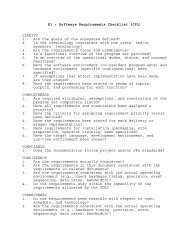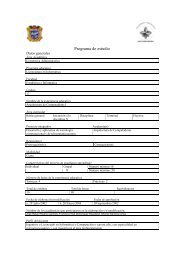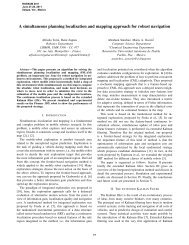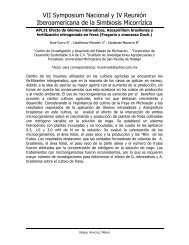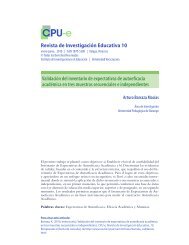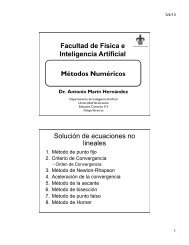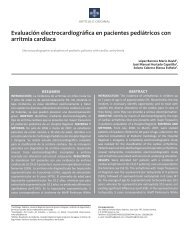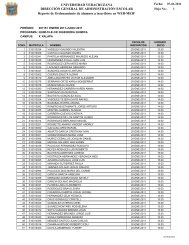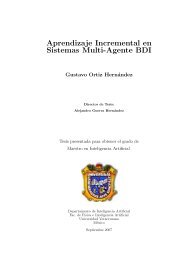Suplemento 2 Vol 8 No 1.indd - Universidad Veracruzana
Suplemento 2 Vol 8 No 1.indd - Universidad Veracruzana
Suplemento 2 Vol 8 No 1.indd - Universidad Veracruzana
Create successful ePaper yourself
Turn your PDF publications into a flip-book with our unique Google optimized e-Paper software.
is a local event involving autocrine and paracrine signaling<br />
within the neuronal assembly where the neurotransmission<br />
took place, that sleep is initiated locally and is, thus,<br />
fundamentally a local process 22,23 .<br />
There is also evidence suggesting that TNF immunoreactivity<br />
in neurons is dependent upon prior activity within<br />
the neurons. Thus within somatosensory cortical columns,<br />
if rat whiskers are repeatedly stimulated, the number of<br />
TNF immunoreactive pyramidal cells is enhanced within<br />
the column receiving afferent input from the stimulated<br />
whisker but not in adjacent columns 24 . Whether this TNF<br />
is produced within the neurons or is that TNF released from<br />
glia by ATP remains unknown. Nevertheless, the results<br />
clearly demonstrate the use-dependency of a SRS. In the<br />
next section, the ability of TNF to promote a local sleep-like<br />
state within cortical columns is described.<br />
Figure 2. The cortical column as the basic unit of brain circuitry regulating<br />
sleep. A cortical column in the wake state exhibits a characteristic input-output<br />
relationship reflecting stimulus processing (left). With continued use, the metabolic<br />
condition of the cortical column changes, leading to enhanced production of<br />
sleep regulatory substances (SRSs) such as neurotrophins and tumor necrosis<br />
factor (TNF) within the column (center). The SRSs in turn alter the input-output<br />
relationship of the cortical column, modifying its stimulus response and rendering<br />
it effectively asleep (right). The use-dependent SRSs also sculpt neuronal and<br />
glial connectivity (center) by inducing synaptic plasticity (using Hebbian and<br />
scaling mechanisms), and this provides a possible function for the sleep state. In<br />
this conceptualization, sleep function is closely linked to local, use-dependent<br />
metabolism, and thus inseparable from sleep regulation. This paradigm provides<br />
a coherent physiological basis for sleep across species ranging from humans and<br />
other mammals to fruit flies and jelly fish.<br />
Table 2. Mechanistic Hypothesis for Local Use-Dependent Sleep<br />
Step 1: Metabolism and electrical activity link sleep regulatory<br />
substance (SRS) release and synthesis via ATP (sleep and metabolism are<br />
connected).<br />
Step 2: SRS production is thus activity-dependent (sleep is homeostatically<br />
driven).<br />
Step 3: SRSs act locally to alter receptive, hence electrical, properties of<br />
nearby neurons and thus alter input-output relationships of the network<br />
within which they are found (sleep is targeted to previously active<br />
networks).<br />
Step 4: The altered input-output network relationships reflect a functional<br />
state change (sleep is local).<br />
Revista Médica<br />
Step 5: Neuronal assembly sleep-like states synchronize with each other<br />
leading to organism state changes (organism sleep is a network emergent<br />
property)(see Roy et al, submitted, for a mathematical model).<br />
Step 6: Sleep regulatory circuits coordinate the individual network (e.g.<br />
cortical columns) functional states into organism sleep architecture (sleep<br />
is adapted to the organism niche).<br />
Step 7: SRSs act on multiple levels of the neural axis to promote sleep<br />
(sleep mechanisms are ubiquitous and evolutionarily ancient).<br />
What sleeps? Sleep as a fundamental process of<br />
neuronal assemblies<br />
A new paradigm for how the brain is organized to produce<br />
sleep posits that sleep regulation is fundamentally a local and<br />
use-dependent process 22,23,25 . This hypothesis is substantially<br />
different from the prevailing view that sleep and wake<br />
states are whole-brain, global phenomena imposed upon<br />
the brain by specialized sleep/wake regulatory circuits.<br />
The paradigm shift has considerable consequences for our<br />
understanding of sleep regulation, sleep pathologies and,<br />
ultimately, sleep function.<br />
Although the involvement of specialized brain<br />
areas in sleep/wake regulation is well documented, there<br />
is no evidence that these specific networks are required<br />
or essential for the occurrence of sleep. Thus, for millions<br />
of stroke patients and thousands of animal brain-lesion<br />
studies, there is not a single report of a post-lesion survivor<br />
who failed to sleep. This suggests that no specific portion<br />
of brain is critically involved in the genesis of sleep per se.<br />
It also suggests that sleep is a fundamental property of any<br />
surviving group of neurons and that it is self-organizing.<br />
It seems likely that brain tissue can express sleep<br />
locally, and that this may occur spontaneously, without<br />
top-down control 22,26 . Isolated cortical islands separated<br />
from thalamic input yet retaining their circulation display<br />
episodic slow waves in the EEG 27 . In whole brain EEG delta<br />
power is recognized as a signature property of NREMS.<br />
Further, as mentioned above, when the SRSs, TNF 10 , or<br />
IL1 28 or GHRH 29 , are applied unilaterally to the cortex in<br />
vivo, they intensify EEG delta power during NREMS but not<br />
during REMS or W. This enhanced EEG delta power occurs<br />
only in the region where these SRSs are applied, not in the<br />
whole brain. These data strongly suggest that at least one<br />
sleep phenotype, EEG delta power, is a local property of<br />
brain tissue. In addition, some species such as birds and<br />
whales exhibit uni-hemispheric sleep; thereby directly<br />
demonstrating that sleep is a property of something less<br />
than the whole brain 30 . Clinical evidence also suggests that<br />
some patients can be awake and asleep simultaneously 31 .<br />
Revista Médica de la <strong>Universidad</strong> <strong>Veracruzana</strong> / <strong>Suplemento</strong> 2 <strong>Vol</strong>. 8 núm. 1, Enero - Junio 2008 49



